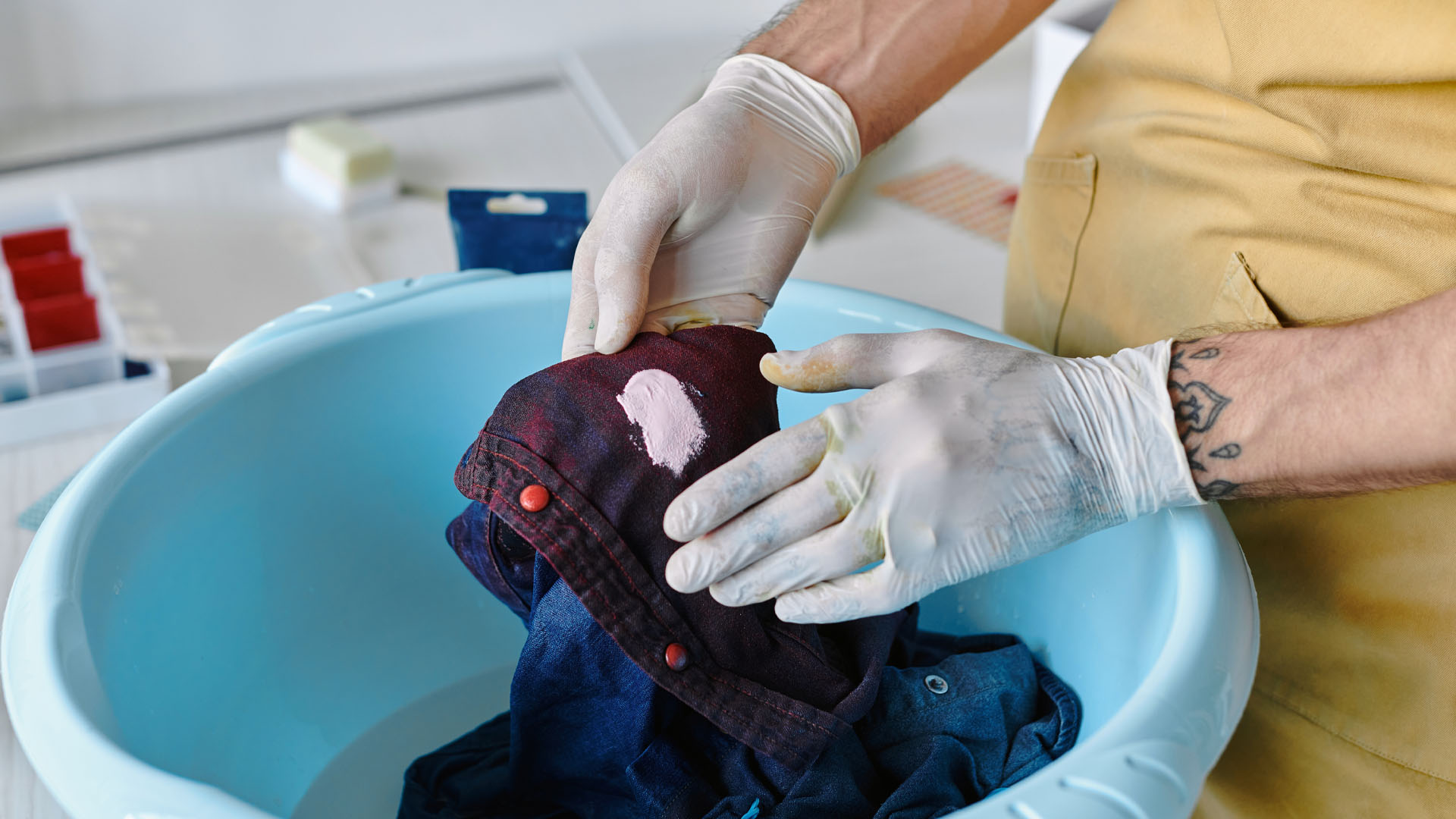
How Do I Get Stinks and Stains Out of Thrifted Clothes?
Decide what your time and energy are worth
Your first step is to determine how much effort you want to put into this particular clothing item. Anything made with a natural fiber—such as linen, silk, cotton, or wool—will be easier to clean and deodorize. Although you can occasionally find high-end garments made of nylon, or quality vintage pieces made of rayon, synthetics can be more of a gamble, especially if they’re made of polyester, which retains odors.
Even with natural fibers, quality matters when it comes to odor removal. Andrea has resurrected multiple thrifted items, including a vintage Hermès silk scarf and a bag of cigarette-smoke-infused table linens, but she has had bad luck with cheap silk.
“Silk itself is incredibly sturdy, though the concern with washing is dye loss. Even high-quality silk will lose some dye, but the difference will be barely noticeable. We thrifted and cleaned a silk scarf of questionable quality. It started green and emerged beige,” she says.
You don’t have to be a fabric expert to gauge a garment’s quality.
“A good cheat code for evaluating fabric is that higher-end materials usually feel both soft and substantial at the same time. They’re better at shedding wrinkles and bouncing back into shape when you scrunch them in your hands,” says editor Alexander Aciman, a textile and menswear obsessive. “Look for garments with higher stitch counts at the seams, zippers that slide smoothly, and internal seams that are smooth and covered rather than exposed. For items like sweaters, especially cashmere, gently rub the fabric between your fingers for a few seconds. If the surface fuzzes up, it probably isn’t worth buying.”
So how do you decide which vintage items can be salvaged? In general, most organic stains, even ancient perspiration stains or burn marks, can be rectified with a careful laundry strategy.
Set-in oily stains are tougher, but we’ve managed to lift oil from all kinds of garments. “For me, any marks from dyes, paints, markers, or permanent ink—especially very large and heavily saturated marks—are a no,” says Andrea. “While it’s possible to remove some of these stains, often it requires harsh solvents and a huge amount of time and effort—sometimes with no decent results.”
Start with the sun and maybe a shot of vodka
Sunshine and a good breeze can do wonders for odors. Hang the item outside for an hour or two to see if the scent dissipates. The sun’s UV rays can kill bacteria lingering in the fabric, and that may be all it takes to breathe new life into a wool coat or a cool sequined skirt.
Andrea did some testing for this article, packing clothes with mothballs (gack) to infuse the scent (blergh) and then attempting to wash it out. Airing the clothes out in the sun worked best.
If you have an item for which you’re not quite sure you want to invest in dry cleaning (say, a wool coat) but needs a bit of fumigating, follow the lead of Broadway costumers, who need to keep custom-dyed items looking bright without washing.
“For items that you’re nervous to wash, we found the best odor fix was a spray bottle filled with vodka. Spritz the garment and let it dry. It might take a few tries, but it worked better than Febreze,” says Andrea.
Being careful not to stretch or dent the fabric, you can put the item out a few different ways. You can hang it on a clothesline; we like the portable Flexo-Line, which you can hang quickly and temporarily if you don’t currently have access to a permanent clothesline.
The Amazon Basics Foldable Laundry Rack is great for when you need to set out multiple items. For more delicate clothing, such as sweaters or lingerie, the OXO Folding Sweater Dryer allows the item to lie flat but have airflow on all sides.
But remember that the sun can fade fabrics as well, so don’t leave delicate dyed fabrics out there too long.
Pretreat mystery stains
Spot-treating stains is so much easier if you know what they are, but don’t fret if you have strange, lingering spots.
If you intend to wash the item, you can pretreat stains with Amodex Ink & Stain Remover, the top pick in our guide to stain removers, which is safe to use on most fabrics.
“Remember to place a small amount of Amodex somewhere hidden and then check for discoloration before using it to remove stains,” warns Andrea.
Try a gentle cycle or a hand wash
You may be wary of throwing delicate items in the wash, but the big secret is that most items, including fabrics such as silk and cashmere, can be machine-washed in a mesh bag on a gentle cycle.
But that doesn’t mean you should throw Great-Meemaw’s perfectly tailored wool coat in the washer. “If it’s a family heirloom, if it’s structured, if it’s made of leather, or you can’t figure out what fiber it’s made from, take it to a dry cleaner,” says Andrea. Better safe than sorry.
If you’re machine-washing, use a mesh bag and the gentle cycle. Although most vintage items can tolerate washing with our top liquid laundry detergent pick, Tide Free & Gentle Liquid Laundry Detergent, it’s better to err on the side of caution and use a laundry detergent that is formulated for delicate pieces. “Delicate” laundry detergents are formulated without protease, an enzyme that erodes proteins. Protease is normally a good thing for getting your clothes clean, but it can damage silk and wool.
Tech fabrics, such as the moisture-wicking nylons and polyesters used to make gym clothes, also require special treatment. My daughter absolutely refuses to wear someone else’s old workout clothes because of any residual sweat or stink, but I buy most of my exercise clothing used (there’s joy in $10 Lululemon stuff, I tell ya). You just need to know how to wash it properly, and thankfully we have instructions on exactly how to do that for workout clothes and items such as rain jackets.
Andrea likes Dirty Labs Hand Wash & Delicates Detergent, from our guide to the best hand wash detergents. This detergent is formulated to be silk- and wool-safe. “They’ve added more glycerine to the formula than other detergents, which is helpful because it loosens stains, but it is incredibly easy on fabric. You could hand-wash a vintage lace wedding dress with this and not worry,” she says.
Avoid your dryer
It may be tempting to simply throw your vintage garment into the washer and then stuff it into the dryer, but high-heat drying will only further set any mystery stains you have in there. You need to wash the clothes first and then air-dry them to ensure that you’ve cleaned the fabric and that you don’t accidentally make any stains harder to remove.
Take a bath
After air drying, if your garment needs brightening or has yellowing that you can’t get out through the normal wash cycle, try a bath with oxygen bleach. Oxygen bleach is ideal for cleaning vintage fabric items because it is both highly effective at removing stains and gentle on fabrics. (Note that while we like this method for fabrics such as linen, cotton, and silk tested for colorfastness, we don’t recommend it for wool or cashmere.)
For most everyday items, we recommend soaks in a solution of Tide Ultra Oxi Powder Laundry Detergent and water for stubborn-stain removal. Use ¼ cup of detergent per gallon of warm or cold water and leave it to soak for 60 minutes. (More stubborn stains may require a longer soak.) Rinse it in a clean water bath afterward.
To best remove cigarette smoke, consider the item itself. For sturdier vintage items such as thickly woven linen or cotton, a soak in a combination of enzymatic detergent and oxygen bleach can do wonders. We prefer Tide Ultra Oxi because it already contains both ingredients. (Andrea would like to use this platform to once again make a public plea to Tide to make this magical powder in an unscented version. I am scent-sensitive, and I would like to amplify this request times 1,000.)
However, when it comes to vintage wear, proceed with caution. Many oxygen bleach powders, including both Tide Ultra Oxi powder and OxiClean, contain fillers and builders that could potentially strip especially delicate fabrics.
Try soaking delicate vintage items with Restoration Fabric Cleaner (which has been frequently out of stock; if you see it, snap it up). Beloved by theater costumers, who often need to get vintage or time-period-specific garments looking their best for the stage, this cleaner contains only two ingredients: sodium percarbonate (oxygen bleach) and baking soda.
The instructions say not to use it on silk, but we were assured by multiple textile experts that most companies don’t want to assume responsibility for anyone’s silk garments, and that oxygen bleach is commonly used on silk.
Restoration is a bit persnickety, especially if you’re soaking silk or other items that should never be washed with hot water. The powder must be diluted with extra-hot water for the powder crystals to fully dissolve before being added to a basin of cooler water.
Submerge the garment and leave it to soak. The length of that soak depends on the severity of the stain, but with pure oxygen bleach and no boosters, it will likely take a minimum of six hours for you to see a big difference. Be patient.
“And seriously, please remember to not use any stain remover or detergent on a delicate item without testing a hidden part of the garment for colorfastness. I cannot stress this enough,” says Andrea. After you’re done, simply hang it up to air-dry as before.
Does all of this sound like too much work for you? I hope not, because your efforts will be rewarded with so many compliments—to which you’ll be able to respond, “Oh, this? It’s thrifted! Isn’t it amazing?!”
